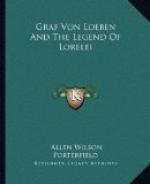That Loeben has been so totally neglected by historians and encyclopedists is simply a case of that disproportion that so frequently characterizes general treatises. Loeben is entitled to some space in large works on German literature; but he was, like many another who has been given space, a weak poet. And the sort of weakness, with which he was endowed can be brought out by a discussion of two of his novelettes, Das weisse Ross,[19] and Leda, neither of which is by any means his best work, and neither of which seems to be his worst. But, to judge from what has been said of his prose works in general, both are quite typical.
The plot so far as the action[20] is concerned is as follows: Otto owes the victory he won at a tournament in NUernberg largely to the beauty and agility of his great white horse Bellerophon. Siegenot von der Aue had seen him and his horse perform and determined to obtain Bellerophon, if possible, for, owing to a curse pronounced on his family by a remote ancestor, Siegenot must either win at the next tournament or become a monk, which he does not wish to do. Both he and Otto love Felicitas, the niece of Graf Berthald. Siegenot secures Bellerophon, is victorious at the tournament, though seriously wounded, and is nursed back to health by Otto and Felicitas. It is Otto, however, who wins Felicitas through his chivalric treatment of his rival. The two are married, while Siegenot rides away on the great white horse Bellerophon.
It is such creations that make us turn away from Loeben. Alas for German romanticism if this story were wholly typical of it! It contains the traditional conceits of the orthodox romanticists, but applied in such a sweet, lovely, pretty fashion! One woman is placed between two men, for in that way Loeben could best bring out his philosophy of friendship. The only change, it seems, that he ever made in this arrangement was to place one man between two women. The sick-bed is poetized as the cradle of knowledge, for in it, or on it, we become introspective and learn life. Old chronicles, tournaments, jewelry, precious stones, Maryism, nature from every conceivable point of view, dreams and premonitions, visions and hallucinations, religion of the renunciatory type, the pain that clarifies, the friendship that weeps, Catholic painting and lute music, and love—human and divine—these are the main themes in this tale. Lyrics and episodic stories are interpolated, obsolete words and stylistic archaisms occur. In short, the novelette reads like an amalgamation of Novalis without his philosophy, Waekenroder without his suggestiveness, and Tieck without his constructive ability.




